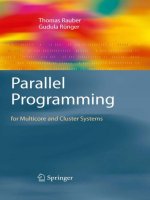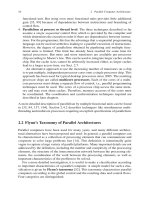Parallel Programming: for Multicore and Cluster Systems- P1 ppsx
Bạn đang xem bản rút gọn của tài liệu. Xem và tải ngay bản đầy đủ của tài liệu tại đây (198.76 KB, 10 trang )
Parallel Programming
Thomas Rauber · Gudula R
¨
unger
Parallel
Programming
For Multicore and Cluster Systems
123
Thomas Rauber
Universit
¨
at Bayreuth
Computer Science Department
95440 Bayreuth
Germany
Gudula R
¨
unger
Technische Universit
¨
at Chemnitz
Computer Science Department
09107 Chemnitz
Germany
ISBN 978-3-642-04817-3 e-ISBN 978-3-642-04818-0
DOI 10.1007/978-3-642-04818-0
Springer Heidelberg Dordrecht London New York
ACM Computing Classification (1998): D.1, C.1, C.2, C.4
Library of Congress Control Number: 2009941473
c
Springer-Verlag Berlin Heidelberg 2010
This is an extended English language translation of the German language edition:
Parallele Programmierung (2nd edn.) by T. Rauber and G. R
¨
unger
Published in the book series: Springer-Lehrbuch
Copyright
c
Springer-Verlag Berlin Heidelberg 2007
Springer-Verlag is part of Springer Science+Business Media.
All Rights Reserved.
This work is subject to copyright. All rights are reserved, whether the whole or part of the material is
concerned, specifically the rights of translation, reprinting, reuse of illustrations, recitation, broadcasting,
reproduction on microfilm or in any other way, and storage in data banks. Duplication of this publication
or parts thereof is permitted only under the provisions of the German Copyright Law of September 9,
1965, in its current version, and permission for use must always be obtained from Springer. Violations
are liable to prosecution under the German Copyright Law.
The use of general descriptive names, registered names, trademarks, etc. in this publication does not
imply, even in the absence of a specific statement, that such names are exempt from the relevant protective
laws and regulations and therefore free for general use.
Cover design: KuenkelLopka GmbH, Heidelberg
Printed on acid-free paper
Springer is part of Springer Science+Business Media (www.springer.com)
Preface
Innovations in hardware architecture, like hyperthreading or multicore processors,
make parallel computing resources available for inexpensive desktop computers.
However, the use of these innovations requires parallel programming techniques.
In a few years, many standard software products will be based on concepts of
parallel programming to use the hardware resources of future multicore proces-
sors efficiently. Thus, the need for parallel programming will extend to all areas
of software development. The application area will be much larger than the area
of scientific computing, which used to be the main area for parallel computing for
many years. The expansion of the application area for parallel computing will lead to
an enormous need for software developers with parallel programming skills. Some
chip manufacturers already demand to include parallel programming as a standard
course in computer science curricula.
This book takes up the new development in processor architecture by giving a
detailed description of important parallel programming techniques that are neces-
sary for developing efficient programs for multicore processors as well as for par-
allel cluster systems or supercomputers. Both shared and distributed address space
architectures are covered. The main goal of the book is to present parallel program-
ming techniques that can be used in many situations for many application areas
and to enable the reader to develop correct and efficient parallel programs. Many
example programs and exercises are provided to support this goal and to show how
the techniques can be applied to further applications. The book can be used as both
a textbook for students and a reference book for professionals. The material of the
book has been used for courses in parallel programming at different universities for
many years.
This is the third version of the book on parallel programming. The first two ver-
sions have been published in German in the years 2000 and 2007, respectively. This
new English version is an updated and revised version of the newest German edition
of the book. The update especially covers new developments in the area of multicore
processors as well as a more detailed description of OpenMP and Java threads.
The content of the book consists of three main parts, covering all areas of par-
allel computing: the architecture of parallel systems, parallel programming models
and environments, and the implementation of efficient application algorithms. The
v
vi Preface
emphasis lies on parallel programming techniques needed for different architec-
tures.
The first part contains an overview of the architecture of parallel systems, includ-
ing cache and memory organization, interconnection networks, routing and switch-
ing techniques, as well as technologies that are relevant for modern and future mul-
ticore processors.
The second part presents parallel programming models, performance models,
and parallel programming environments for message passing and shared memory
models, including MPI, Pthreads, Java threads, and OpenMP. For each of these
parallel programming environments, the book gives basic concepts as well as more
advanced programming methods and enables the reader to write and run semanti-
cally correct and efficient parallel programs. Parallel design patterns like pipelining,
client–server, and task pools are presented for different environments to illustrate
parallel programming techniques and to facilitate the implementation of efficient
parallel programs for a wide variety of application areas. Performance models and
techniques for runtime analysis are described in detail, as they are a prerequisite for
achieving efficiency and high performance.
The third part applies the programming techniques from the second part to repre-
sentative algorithms from scientific computing. The emphasis lies on basic methods
for solving linear equation systems, which play an important role in many scientific
simulations. The focus of the presentation lies on the analysis of the algorithmic
structure of the different algorithms, which is the basis for parallelization, and not on
the mathematical properties of the solution methods. For each algorithm, the book
discusses different parallelization variants, using different methods and strategies.
Many colleagues and students have helped to improve the quality of this book.
We would like to thank all of them for their help and constructive criticisms. For
numerous corrections and suggestions we would like to thank J
¨
org D
¨
ummler, Mar-
vin Ferber, Michael Hofmann, Ralf Hoffmann, Sascha Hunold, Matthias Korch,
Raphael Kunis, Jens Lang, John O’Donnell, Andreas Prell, Carsten Scholtes, and
Michael Schwind. Many thanks to Matthias Korch, Carsten Scholtes, and Michael
Schwind for help with the exercises. We thank Monika Glaser for her help and
support with the L
A
T
E
X typesetting of the book. We also thank all the people who
have been involved in the writing of the first two German versions of this book. It
has been a pleasure working with the Springer Verlag in the development of this
book. We especially thank Ralf Gerstner for his support and patience.
Bayreuth Thomas Rauber
Chemnitz Gudula R
¨
unger
August 2009
Contents
1 Introduction 1
1.1 ClassicalUseofParallelism 1
1.2 Parallelism in Today’s Hardware 2
1.3 Basic Concepts . . . . 3
1.4 OverviewoftheBook 5
2 Parallel Computer Architecture 7
2.1 Processor Architecture and Technology Trends . . . . . . 7
2.2 Flynn’s Taxonomy of Parallel Architectures . . 10
2.3 MemoryOrganizationofParallelComputers 12
2.3.1 ComputerswithDistributedMemoryOrganization 12
2.3.2 Computers with Shared Memory Organization . . . . . . . 15
2.3.3 Reducing Memory Access Times 17
2.4 Thread-Level Parallelism . . 20
2.4.1 Simultaneous Multithreading . . . 21
2.4.2 MulticoreProcessors 22
2.4.3 ArchitectureofMulticoreProcessors 24
2.5 Interconnection Networks . . 28
2.5.1 Properties of Interconnection Networks . . . . . . 29
2.5.2 Direct Interconnection Networks 32
2.5.3 Embeddings. . . . . . . 37
2.5.4 Dynamic Interconnection Networks . . 40
2.6 RoutingandSwitching 46
2.6.1 RoutingAlgorithms 46
2.6.2 RoutingintheOmegaNetwork 53
2.6.3 Switching 56
2.6.4 Flow Control Mechanisms . . . . . . 63
2.7 Caches and Memory Hierarchy . 64
2.7.1 Characteristics of Caches . . . . . . . 65
2.7.2 WritePolicy 73
2.7.3 Cache Coherency . . 75
2.7.4 MemoryConsistency 82
2.8 Exercises for Chap. 2. . . . . . 88
vii
viii Contents
3 Parallel Programming Models 93
3.1 Models for Parallel Systems 93
3.2 ParallelizationofPrograms 96
3.3 LevelsofParallelism 98
3.3.1 ParallelismatInstructionLevel 98
3.3.2 DataParallelism 100
3.3.3 LoopParallelism 102
3.3.4 Functional Parallelism . . 104
3.3.5 ExplicitandImplicitRepresentationofParallelism 105
3.3.6 ParallelProgrammingPatterns 108
3.4 DataDistributionsforArrays 113
3.4.1 Data Distribution for One-Dimensional Arrays 113
3.4.2 Data Distribution for Two-Dimensional Arrays . . . . . . 114
3.4.3 ParameterizedDataDistribution 116
3.5 Information Exchange . . . . . 117
3.5.1 Shared Variables . . . 117
3.5.2 CommunicationOperations 118
3.6 Parallel Matrix–Vector Product . 125
3.6.1 Parallel Computation of Scalar Products . . . . . 126
3.6.2 Parallel Computation of the Linear Combinations . . . . 129
3.7 Processes and Threads . . . . . 130
3.7.1 Processes 130
3.7.2 Threads . . . 132
3.7.3 Synchronization Mechanisms . . . 136
3.7.4 DevelopingEfficientandCorrectThreadPrograms 139
3.8 Further Parallel Programming Approaches . . . 141
3.8.1 Approaches for New Parallel Languages . . . . . 142
3.8.2 Transactional Memory . . 144
3.9 Exercises for Chap. 3. . . . . . 147
4 Performance Analysis of Parallel Programs 151
4.1 Performance Evaluation of Computer Systems . . . . . . 152
4.1.1 Evaluation of CPU Performance . 152
4.1.2 MIPSandMFLOPS 154
4.1.3 Performance of Processors with a Memory Hierarchy . 155
4.1.4 Benchmark Programs . . . 158
4.2 Performance Metrics for Parallel Programs . . 161
4.2.1 Speedup and Efficiency . 162
4.2.2 Scalability of Parallel Programs . 165
4.3 Asymptotic Times for Global Communication . . . . . . . 166
4.3.1 Implementing Global Communication Operations . . . . 167
4.3.2 Communications Operations on a Hypercube . 173
4.4 AnalysisofParallelExecutionTimes 181
4.4.1 Parallel Scalar Product . . 181
Contents ix
4.4.2 Parallel Matrix–Vector Product . . 183
4.5 Parallel Computational Models . 186
4.5.1 PRAM Model . . . . . 186
4.5.2 BSP Model 189
4.5.3 LogP Model . . . . . . . 191
4.6 Exercises for Chap. 4. . . . . . 193
5 Message-Passing Programming 197
5.1 Introduction to MPI 198
5.1.1 MPIPoint-to-PointCommunication 199
5.1.2 Deadlocks with Point-to-Point Communications . . . . . 204
5.1.3 Non-blocking Operations and Communication Modes . 208
5.1.4 CommunicationMode 212
5.2 CollectiveCommunicationOperations 213
5.2.1 CollectiveCommunicationinMPI 214
5.2.2 Deadlocks with Collective Communication . . . 227
5.3 Process Groups and Communicators . . . . 229
5.3.1 Process Groups in MPI. . 229
5.3.2 Process Topologies . 234
5.3.3 TimingsandAbortingProcesses 239
5.4 Introduction to MPI-2 . . . . . 240
5.4.1 Dynamic Process Generation and Management . . . . . . 240
5.4.2 One-SidedCommunication 243
5.5 Exercises for Chap. 5. . . . . . 252
6 Thread Programming 257
6.1 Programming with Pthreads 257
6.1.1 Creating and Merging Threads . . 259
6.1.2 Thread Coordination with Pthreads . . 263
6.1.3 Condition Variables 270
6.1.4 Extended Lock Mechanism . . . . . 274
6.1.5 One-Time Initialization . 276
6.1.6 Implementation of a Task Pool . . 276
6.1.7 ParallelismbyPipelining 280
6.1.8 Implementation of a Client–Server Model 286
6.1.9 Thread Attributes and Cancellation . . 290
6.1.10 Thread Scheduling with Pthreads 299
6.1.11 PriorityInversion 303
6.1.12 Thread-Specific Data . . . 306
6.2 Java Threads . . 308
6.2.1 Thread Generation in Java . . . . . . 308
6.2.2 Synchronization of Java Threads 312
6.2.3 WaitandNotify 320
6.2.4 Extended Synchronization Patterns . . 326









